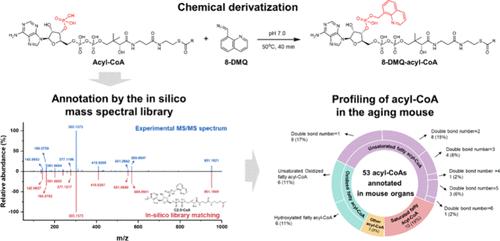An 8-(Diazomethyl) Quinoline Derivatized Acyl-CoA in Silico Mass Spectral Library Reveals the Landscape of Acyl-CoA in Aging Mouse Organs
IF 6.7
1区 化学
Q1 CHEMISTRY, ANALYTICAL
引用次数: 0
Abstract
Acyl-Coenzyme As (acyl-CoAs) are essential intermediates to incorporate carboxylic acids into the bioactive metabolic network across all species, which play important roles in lipid remodeling, fatty acids, and xenobiotic carboxylic metabolism. However, due to the poor liquid chromatographic behavior, the relatively low mass spectrometry (MS) sensitivity, and lack of authentic standards for annotation, the in-depth untargeted profiling of acyl-CoAs is challenging. We developed a chemical derivatization strategy of acyl-CoAs by employing 8-(diazomethyl) quinoline (8-DMQ) as the labeling reagent, which increased the detection sensitivity by 625-fold with good peak shapes. By applying the MS/MS fragmentation rules learned from the MS/MS spectra of 8-DMQ-acyl-CoA authentic standards, an 8-DMQ-acyl-CoA in silico mass spectral library containing 33,344 high-resolution tandem mass spectra of 8,336 acyl-CoA species was created. The in silico library facilitated the high-throughput and automatic annotation of acyl-CoA using multiple metabolomic data processing tools, such as NIST MS Search and MSDIAL. The feasibility of the in silico library in a complex sample was demonstrated by profiling endogenous acyl-CoAs in multiple organs of an aging mouse. 53 acyl-CoA species were annotated, including 12 oxidized fatty acyl-CoAs and 3 novel nonfatty acyl-CoAs. False positive annotations were further screened by developing an eXtreme Gradient Boosting (XGBoost) based retention time prediction model. The organ distribution and the aging dynamics of acyl-CoAs in a mouse model were discussed for the first time, which helped to elucidate the organ-specific function of acyl-CoAs and the role of different acyl-CoA species during aging.

8-(重氮甲基)喹啉衍生化酰基-CoA 硅质谱库揭示了老化小鼠器官中酰基-CoA 的分布情况
酰基辅酶As(acyl-CoAs)是所有物种将羧酸纳入生物活性代谢网络的重要中间体,在脂质重塑、脂肪酸和异生物羧基代谢中发挥着重要作用。然而,由于液相色谱性能差、质谱(MS)灵敏度相对较低以及缺乏用于注释的真实标准,对酰基-CoAs 进行深入的非靶向分析具有挑战性。我们采用 8-(重氮甲基)喹啉(8-DMQ)作为标记试剂,开发了一种酰基-CoAs 化学衍生化策略,将检测灵敏度提高了 625 倍,且峰形良好。通过应用从 8-DMQ-acyl-CoA 真品标准品的 MS/MS 图谱中学到的 MS/MS 碎片规则,创建了一个 8-DMQ-acyl-CoA 硅质谱库,其中包含 8,336 种酰基-CoA 的 33,344 个高分辨率串联质谱图。通过使用多种代谢组学数据处理工具(如 NIST MS Search 和 MSDIAL),该硅学质谱库有助于对酰基-CoA 进行高通量自动注释。通过分析衰老小鼠多个器官中的内源性酰基-CoA,证明了硅库在复杂样本中的可行性。共注释了 53 种酰基-CoA,包括 12 种氧化脂肪酰基-CoA 和 3 种新型非脂肪酰基-CoA。通过开发基于梯度提升(XGBoost)的保留时间预测模型,进一步筛选了假阳性注释。该研究首次讨论了酰基-CoAs在小鼠模型中的器官分布和衰老动态,有助于阐明酰基-CoAs的器官特异性功能以及不同酰基-CoAs物种在衰老过程中的作用。
本文章由计算机程序翻译,如有差异,请以英文原文为准。
求助全文
约1分钟内获得全文
求助全文
来源期刊

Analytical Chemistry
化学-分析化学
CiteScore
12.10
自引率
12.20%
发文量
1949
审稿时长
1.4 months
期刊介绍:
Analytical Chemistry, a peer-reviewed research journal, focuses on disseminating new and original knowledge across all branches of analytical chemistry. Fundamental articles may explore general principles of chemical measurement science and need not directly address existing or potential analytical methodology. They can be entirely theoretical or report experimental results. Contributions may cover various phases of analytical operations, including sampling, bioanalysis, electrochemistry, mass spectrometry, microscale and nanoscale systems, environmental analysis, separations, spectroscopy, chemical reactions and selectivity, instrumentation, imaging, surface analysis, and data processing. Papers discussing known analytical methods should present a significant, original application of the method, a notable improvement, or results on an important analyte.
 求助内容:
求助内容: 应助结果提醒方式:
应助结果提醒方式:


